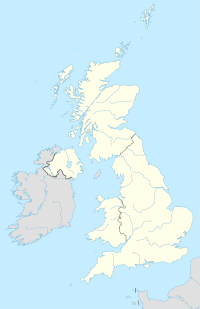Dunwich
Coordinates: 52 ° 17 ' N , 1 ° 38' E
The place Dunwich [ ˈdʌnɪt im ] in County Suffolk in England is the remnant of a formerly prosperous seaport and center of the wool trade in the early Middle Ages . The natural harbor at the confluence of the Blyth and Dunwich Rivers was once the largest port city in East Anglia .
history
The port of Dunwich provided the basis for a Roman military camp. It was first mentioned in documents in 632 when a missionary from Burgundy, St. Felix , founded the first bishopric in East Anglia in Dunwich . After the Domesday Book , the People and asset counting the Norman conquerors from the year 1086, Dunwich had about 3,000 inhabitants, eight churches, a Benedictine abbey and two monasteries of the Franciscans and Dominicans . It was the tenth largest city in England. In the 13th century it was the second largest city in East Anglia after Norwich, with eighteen churches and monasteries .
In Roman times, the coastline was at least 2000 m away from today's city. During a violent storm in 1286, large parts of the city were washed into the sea and the mouth of the Dunwich River partially silted up. Against another violent storm surge in 1328, the residents fought in vain to save the port. A quarter of the city of Dunwich was submerged in the sea. Much of the remaining city was torn into the sea on January 15 and 16, 1362 by a severe winter storm. At the same time the German North Sea coast was devastated by the " Grote Mandrenke ". Over the next three centuries, the rest of the city fell victim to coastal erosion . Houses that are now directly on the cliff were once almost two kilometers inland.
Almost all of the buildings are submerged in the sea, including all eight churches. The last remains of the All Saints Church, which had no pastor since 1755, fell into the sea in 1904 and 1919. Only a few walls of a Franciscan monastery and a leprosy hospital remain. A legend tells that with some storm surges you can still hear the church bells in the roar of the waves. Once a major city, Dunwich had the right to two members of Parliament . It was not until 1832, after the rotten boroughs were cleared up by the Reform Act , that Dunwich lost this right.
For the few remaining residents, a new church, St. James, was built a little inland in 1832. These, the Ship Inn, a tea room, a museum worth seeing and a few houses with around 120 inhabitants are the rest of the once important city. In spring 2013, with the help of sonar technology, the first map of the ruins of Dunwich, which are now three to ten meters deep, was drawn up by the University of Southampton .
The landscape in the area offers a variety of nature experiences. The now completely silted up mouth of the Dunwich River in the north, called Dingle Marshes, no longer suggests that one of the most important English ports was located here. Large heaths with Erika , gorse and tree and shrub groups Dunwich Heath , cover the former pasture land in the south. There is the Minsmere bird reserve in an extensive reed area.
Lost Town
In 2004 the young architects Anne Niemann and Johannes Ingrisch won a lavish architecture competition and were given the opportunity to initiate an art project costing several million pounds , the representation of a church in the sea off the coast through metal columns. After persistent opposition from Dunwich residents, after years of effort, the focus of the project was shifted to The Naze Peninsula near Walton-on-the-Naze . Due to the global financial crisis, the project has been suspended since 2009. The long-term documentary Lost Town accompanied the work.
Individual evidence
- ↑ a b What ever happended to Dunwich? ( Memento of the original from January 1, 2017 in the Internet Archive ) Info: The archive link was inserted automatically and has not yet been checked. Please check the original and archive link according to the instructions and then remove this notice. Dunwich Museum website
- ^ A b Archaeologists map lost medieval Suffolk town of Dunwich under the sea Guardian May 10, 2013, accessed May 11, 2013
- ↑ Lost Town ( Memento from April 25, 2010 in the Internet Archive ) at wdr.de, sent April 23, 2010
literature
- SE Rigold: The Supposed See of Dunwich , J. Brit. Archaeol.Ass., XXIV, 1961, pp. 5-59.
- Peter Sager: Eastern England: Suffolk, Norfolk and Essex . DuMont, Cologne 1990, ISBN 3-7701-1713-1 .
- Winfried G. Sebald: The rings of Saturn: an English pilgrimage . 7th edition, Fischer Taschenbuch-Verlag, Frankfurt am Main 2003, ISBN 3-596-13655-5 .
- Dunwich and the lost City with Walberswick to Minsmere Walks . Heritage House (Editor), ISBN 1-85215-052-1 .
Web links
- Dunwich Museum website
- All Saints, Dunwich (English)
- Low tide reveals lost city find (BBC News, October 10, 2005)
- Abandoned Communities - Dunwich (English)


